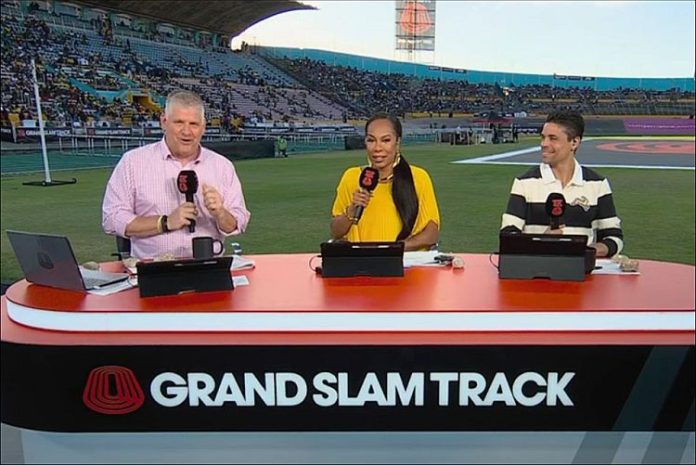★ The Sports Examiner: Chronicling the key competitive, economic and political forces shaping elite sport and the Olympic Movement.★
★ To get the daily Sports Examiner Recap by e-mail: sign up here! ★
≡ GRAND SLAM TRACK DEBUT ≡
“We thought it would be amazing. We thought that if you took in the world and you put them together, where they can compete against their rivals, the fans would love it, and the athletes as well would love it. And that is exactly what has happened.
“So it is truly exactly what we thought would happen and we’re so proud of what we’ve been able to accomplish over the last three days, to show what’s truly possible and the real potential of this sport. I’ve always thought this sport has not really ever achieved its potential. We still aren’t there, but we’re getting there. We’ll keep building, we’ll keep working, but this shows what this sport can be about, and it shows how great these athletes are.”
That’s Michael Johnson, the four-time Olympic gold medalist, talking about the debut of his Grand Slam Track circuit after the close of the inaugural Slam in Kingston, Jamaica on Sunday.
The three-day meet had a lot going for it:
● Nine outdoor world-leading marks, in the men’s 400 m and 400 m hurdles, and the women’s 400 m, 800 m, 1,500 m, 3,000 m, 5,000 m, 100 m hurdles and 400 m hurdles.
● Lots of big names, led by hurdles superstar Sydney McLaughlin-Levrone, but also the very interesting men’s 800-1,500 m showdowns with five of the six Paris medalists, and the 800 m stars trashing the milers.
● Television agreements that placed the meet in 189 countries and territories, although with no indications of audience information yet.
Johnson, asked what the highlight was for him of the opening weekend:
“Honestly, it was the response from fans, whether that be the fans who watched on television, and went on social media saying ‘This is exactly what the sport needs,’ or the fans who were in the stands, who were just so engaged and appreciating these athletes. That was the highlight.
“I thought that this format could be great … but the real validation is when the fans go, ‘this is great.’”
There were naysayers, of course and television host John Anderson, the former ESPN SportsCenter anchor, made the point that this is a work in progress. So, there were obvious areas that need attention:
● Attendance was the first thing to be noticed. Panam Sports posted daily stories, reporting “no more than 2,000 people” on Friday, and “more than 5,000″ on Saturday, and no total for Sunday, which appeared to be less than Saturday. I thought it was a bit more, but no attendance figures were reported.
● Jamaica’s National Stadium holds about 35,000, so if the same number of people show up for the next meet in Miramar, Florida – with about 5,000 seats – the place will be full! So it’s more about the look and feel of the audience than the number and the crowd in Kingston was loud at times, with plenty of horns blowing throughout the meet.
● For the television audience, the viewing experience was far poorer than what has been seen for Diamond League meets or U.S. national championships. Graphics were tiny, splits were late and hard to read and the results were also in a small font size. There were no wind readings on most of the sprint results; this matters to the sport’s actual fan base.
● Fans trying to follow the results on the Grand Slam Track site had even more trouble, as races were sometimes not posted for 15 minutes. No splits were provided, and the only thing that really mattered appeared to be the Slam point standings.
This is an area which the Diamond League has perfected, as well as the USATF championship events, which are also excellent and provided by U.S. companies.
● Grand Slam Track insisted that athlete bibs – formerly with numbers, but now with names – are not necessary, but those who did not have their names on their uniforms were essentially anonymous. With a few exceptions, college and professional team uniforms have names and numbers to allow fans to identify the players. This is true in track too; EVERYONE needs to have their name on their uniform, even if it’s only their first name, as many athletes preferred in Kingston.
The format of the television show had the right idea, but spotty execution.
The Grand Slam Track broadcast was essentially a talk show between Anderson and Olympic champions Sanya Richards-Ross and Matthew Centrowitz, with the live events spliced in at the last moment. The lack of a world-class results system – as at the Diamond League – clearly hampered play-by-play man Steve Cram (GBR), the 1983 World 1,500 m champion, as well as analysts Anson Henry (CAN) and Carrie Tollefson (USA) and their calls showed it. No doubt they will be better prepared for the meet in Miramar in May.
The pre-event and post-event interviews with athletes was less than might be hoped for in a fully-professionalized league which is primarily a television show. And what about talking to some fans in the stands, or pre-set autograph stations after races?
But the idea of baking in a “pre-game” and “post-game” show into the main body of the broadcast window was a good idea. It will have to be refined, but the concept is right.
¶
One element which was noted before the meet started were betting lines on the races at the DraftKings Sportsbook. However, the lines were not incorporated into the broadcast commentary or shown on the screen.
This is an area to watch; it would be fascinating to know if there were any reports on the betting handle for the weekend.
¶
Start-ups are hard. It is worth celebrating that almost all of the athletes who were promised showed up and that’s good. Seeing McLaughlin in a strong-effort race in April was a treat, as was Wanyonyi spanking the 1,500 m stars at their own distance, and Grant Fisher sprinting all-out in the final 50 m of the ultra-slow 5,000 m on Sunday to get third, so he would win the $100,000 first prize.
And how about last-second invitee Jenna Prandini winning $50,000 for the weekend in the women’s short sprints? A great story for an accomplished sprinter who has been seen to be on the downside of her career. Maybe not now?
If you’re looking for a grade, it’s a generous “B.” The concept is real, it happened, and $3.15 million in prize money was paid to the competitors. Don’t forget the nine world-leading performances, either.
This meet lost money, for sure. But for Johnson, he has no one to answer to except his investors and they will be impressed that his idea is off the ground.
Now, the key will be to show improvement for the next meets in Miramar, Philadelphia and Los Angeles.
Rich Perelman
Editor
★ Receive our exclusive, weekday TSX Recap by e-mail by clicking here.
★ Sign up a friend to receive the TSX Recap by clicking here.
★ Please consider a donation here to keep this site going.
For our updated, 694-event International Sports Calendar for 2025 and beyond, by date and by sport, click here!























